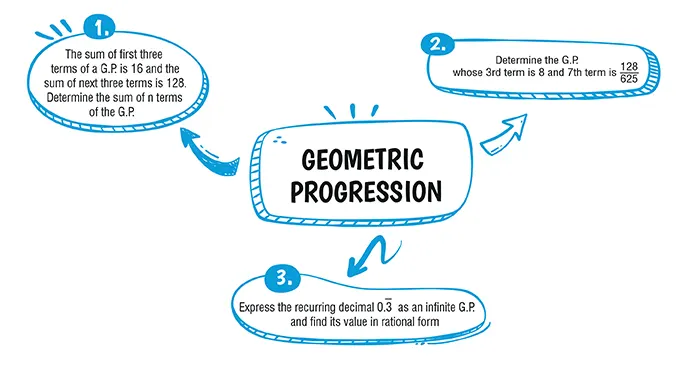

Some important questions related to Chapter 10 - Geometric Progression in ICSE Class 10 Mathematics. These questions cover various concepts and can help you prepare for your exams. Remember to solve these questions and practice other exercises from your textbook to thoroughly understand the topic.
We've put together a collection of essential geometric progression class 10 ICSE questions specifically focused on Class 10 Geometric Progression. These questions serve as a valuable resource to bolster students' mathematical proficiency, address any uncertainties they may have, and conquer potential challenges encountered during their study of this topic. By working through these questions, students can fortify their understanding of this fundamental mathematical concept, ultimately equipping themselves to excel in their Class 10 Mathematics examinations.
In chapter 10 of Class 10 Mathematics, Geometric Progression ICSE Mathematics, students are introduced to the concept of a Geometric Progression (GP), also known as a Geometric Sequence. A Geometric Progression is a fundamental mathematical sequence with a unique pattern. It is defined as a sequence of numbers where each term is found by multiplying the preceding term by a constant number called the "common ratio."
Here's an introductory explanation of a Geometric Progression for Class 10 students:
A Geometric Progression (GP) is a sequence of numbers that follows a specific multiplication pattern. In a GP, each term is obtained by multiplying the previous term by the same fixed number, known as the "common ratio." This common ratio is represented by the letter "r."
The general form of a Geometric Progression looks like this:
a, ar, ar2, ar3, ar4, ...
Where:
"a" is the first term of the sequence.
"r" is the common ratio.
A Geometric Progression (GP) as we study in geometric progression class 10 ICSE is a sequence of numbers where each number is found by multiplying the previous one by the same amount. This special amount we multiply by is called the "common ratio."
Imagine you have a starting number, let's call it "a." Then, to find the next number in the sequence, you don't add or subtract like in some other sequences. Instead, you multiply "a" by a fixed number "r" to get the next number, and you keep doing this for all the numbers in the sequence.
So, if "a" is 2, and "r" is 3, our GP would look like this:
2, 6, 18, 54, 162, ...
Here's a breakdown of the terms:
The first term is 2 (that's just our starting number).
To get the second term, we multiply the first term (2) by the common ratio (3), so we get 2 * 3 = 6.
To find the third term, we multiply the second term (6) by the common ratio (3) again, giving us 6 * 3 = 18.
We keep doing this for each term in the sequence.

Ans. (c) 128
Explanation:
11th term of the G.P.
\(\frac{1}{8},\frac{-1}{4}\),2,-1,....is
Here, First term (a)=\(\frac{1}{8}\)
Common ratio (r)=\(\frac{-1}{4}\)÷\(\frac{1}{8}\)
=\(\frac{-1}{4}\)×\(\frac{8}{1}\)=--2
=-\(\frac{1}{4}\)×8=--2
11th term of G.P.=a11 a11 = arn-1
\(= \frac{1}{2^3} × (–1)^{10} × 2^{10} \)
=1×210-3
=27
=128.
Ans. (a)
Explanation:
\(\frac{1}{9},\frac{1}{3}\),1,-3....
Here,Firstterm (a) = \(\frac{1}{9}\)
=\(\frac{-1}{3}\)÷\(\frac{1}{9}\)
=\(\frac{-1}{3}\) = 9
= - 3
It is a G.P. with r = – 3.
Explanation:
Let a be the first term and r be the common ratio of the G.P. Then, according to given condition,
a + ar + ar2 = 16 …(i)
and ar3 + ar4 + ar5 = 128 …(ii)
⇒ a (1 + r + r2) = 16
and ar3 (1 + r + r2) = 128
⇒ \(\frac{ar^3(1+r+r^2)}{a(1+r+r^2)}\)=\(\frac{128}{16}\)
⇒ r3 = 8
⇒ r = 2
Putting r = 2 in equation (i), we get
a + 2a + 4a = 16
⇒ 7a = 16
⇒ a= \(\frac{16}{7}\)
∴ Sum of n terms, Sn = \(\frac{a(r-1)}{r - 1}\)
⇒ Sn = \( \frac{16}{7} \left(\frac{2^n – n}{2 – 1} \right) \)
=\(\frac{16}{7}(2n-1)\)
Explanation:
Given:
a3 = 8 and a7 = \(\frac{128}{625}\)
Let a, ar, ar2, …… be the G.P.
Then, a3 = ar2 and a7 = ar6
Now, \(\frac{a_7}{a_3}\) = \(\frac{ar^6}{ar^2}\) = r4 and \(\frac{a_7}{a_3}\) = \(\frac{128}{625×8}\) =\(\frac{16}{625}\)
∴ r4 = \(\frac{16}{625} = \begin{pmatrix} \frac{2}{5}\end{pmatrix}^4\)
\(\Rightarrow\) r = ±\(\frac{2}{5}\)
As ar2 = 8
a = 8 ×\(\begin{pmatrix} \frac{5}{2}\end{pmatrix}^2\)
=\(\frac{8×25}{4}\) = 50
∴ G.P. is 50, 20, 8, …… (when r = 2/5).
or 50, – 20, 8, …… (when r = – 2/5).
Explanation:
0.\(\={3}\) =0⋅3333333…
=0⋅3+0⋅03+0⋅003+0⋅0003+...
=\(\frac{3}{10}\)+\(\frac{3}{10^2}\)+\(\frac{3}{10^3}\)+\(\frac{3}{10^4}\)+.........
The above is an infinite G.P. with the first term
a=\(\frac{3}{10}\)and r =\(\frac{\frac{3}{10^2}}{\frac{3}{10}}\)=\(\frac{1}{10}\)<1
Hence, by using the formula
S=\(\frac{a}{1-r}\), we get
0. \(\={3}\) =\(\frac{\frac{3}{10}}{1-\frac{1}{10}}\)=\(\frac{\frac{3}{10}}{\frac{9}{10}}\)
=\(\frac{3}{9}\)=\(\frac{1}{3}\)
Hence, the recurring decimal 0.\(\={3}\) = \(\frac{1}{3}\).


In geometric progression class 10 ICSE, geometric progression is a sequence of numbers in which each term after the first is found by multiplying the previous term by a fixed, non-zero number called the common ratio (r).
If you're enthusiastic about enhancing your expertise and cultivating a more profound comprehension of the concepts addressed, you'll discover a plethora of geometric progression class 10 ICSE questions on oswal.io. These educational resources are crafted to support your quest for a deeper grasp of the subject matter, empowering you on your educational journey.
Ans: A GP is a sequence of numbers in which each term is obtained by multiplying the preceding term by a constant non-zero number called the common ratio.
Ans: The common ratio (r) is calculated by dividing any term in the GP by its preceding term:
r=\(\frac{a_n}{a_{n-1}}\)
Ans: The nth term of a GP is given by: an = a. r(n-1).
Ans: The sum of the first 'n' terms of a GP is calculated using the formula: sn=\(\frac{a(r^n-1)}{r-1}\).
Ans: If r is greater than 1, the GP is increasing, and the terms become larger as the sequence progresses.